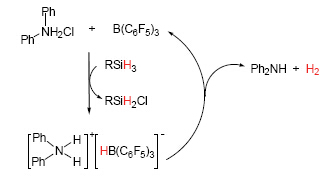| [1] Welch, G. C.; San Juan, R. R.; Masuda, J. D.; Stephan, D. W. Science 2006, 314, 1124.
[2] Welch, G. C.; Stephan, D. W. J. Am. Chem. Soc. 2007, 129, 1880.
[3] Spies, P.; Erker, G.; Kehr, G.; Bergander, K.; Fraeohlich, R.; Grimme, S.; Stephan, D. W. Chem. Commun. 2007, 47, 5072.
[4] Chen, D. J.; Wang, Y.; Klankermayer, J. Angew. Chem., Int. Ed. 2010, 49, 9475.
[5] Stephan, D. W.; Erker, G. Angew. Chem., Int. Ed. 2010, 49, 46.
[6] Liu, Y.-B.; Du, H.-F. Acta Chim. Sinica 2014, 72, 771. (刘勇兵, 杜海峰, 化学学报, 2014, 72, 771.)
[7] Feng, X.-Q.; Du, H.-F. Tetrahedron Lett. 2014, 55, 6959.
[8] Focante, F.; Mercandelli, P.; Sironi, A.; Resconi, L. Coord. Chem. Rev. 2006, 250, 170.
[9] Millot, N.; Santini, C. C.; Fenet, B.; Basset, J. M. Eur. J. Inorg. Chem. 2002, 3328.
[10] Sumerin, V.; Schulz, F.; Atsumi, M.; Wang, C.; Nieger, M.; Leskelae, M.; Repo, T.; Pyykkoe, P.; Rieger, B. J. Am. Chem. Soc. 2008, 130, 14117.
[11] Sumerin, V.; Schulz, F.; Nieger, M. Angew Chem., Int. Ed. 2008, 47, 6001.
[12] Schulz, F.; Sumerin, V.; Heikkinen, S.; Pedersen, B.; Wang, C.; Atsumi, M.; Leskelae, M.; Repo, T.; Pyykkoe, P.; Petry, W.; Rieger, B. J. Am. Chem. Soc. 2011, 133, 20245.
[13] Xu, Y.-Y.; Li, Z.; Borzov, M.; Nie, W.-L. Prog. Chem. 2012, 24(8), 1526. (徐莹莹, 李钊, Borzov Maxim, 聂万丽, 化学进展, 2012, 24(8), 1526.)
[14] Hu, X.; Tian, C.; Borzov, M.; Nie, W.-L. Acta Chim. Sinica 2015, 73, 1025. (胡茜, 田冲, Borzov Maxim, 聂万丽, 化学学报, 2015, 73, 1025.)
[15] Tian, C.; Borzov, M. V.; Liu, Q. CN104262374, 2015. [Chem. Abstr. 2015, 162, 219382]. (聂万丽, 田冲, Borzov, M. V., 刘芹, 专利申请号CN201410415316.7, 2014.)
[16] Nie, W.-L.; Tian, C.; Borzov, M. V.; Hu, X. CN104258904, 2015. [Chem. Abstr. 2015, 162, 209551]. (聂万丽, 田冲, Borzov, M. V.,胡茜, 专利申请号CN201410415003.1, 2014.)
[17] Nie, W.-L.; Tian, C.; Borzov, M. V.; Jiang, Y. CN104230975, 2014. [Chem. Abstr. 2014, 162, 123052]. (聂万丽, 田冲, Borzov, M. V.,姜亚, 专利申请号CN201410415290.6, 2014.)
[18] Roesler, R.; Piers, W. E.; Parvez, M. J. Organomet. Chem. 2003, 680, 218.
[19] Cunico, R. F.; Bedell, L. J. Org. Chem. 1980, 45, 4797.
[20] Khalafi-Nezhad, A.; Alamdari, R. F.; Zekri, N. Tetrahedron 2000, 56, 7503.
[21] Kunai, A.; Sakurai, T.; Toyoda, E.; Ishikawa, M. J. Organomet. Chem. 1996, 15, 2478.
[22] Kunai, A.; Ohshita, J. Organometallics 2003, 686, 3.
[23] Ferreri, C.; Costantino, C.; Romeo, R.; Chatgilialoglu, C. Tetrahedron Lett. 1999, 40, 1197. |
